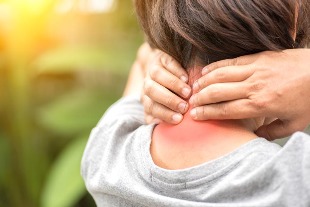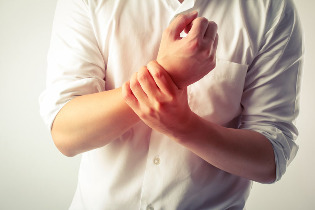Osteochondrosis is a disease, which is one of the most popular in the world. Most people after age 35 have osteochondrosis of the cervical spine in one form or another. Recently there has been a tendency to increase the number suffering from a severe form of the disease and the rejuvenation of the disease, reduction of the lower age limit. It POV due to the fact that an increasing number of people around the world engaged in sedentary work and a sedentary lifestyle. Meanwhile, quite a dangerous disease, and everyone should know, what is osteoarthritis, how it manifests itself and how it is cured, to be able to recognize its symptoms and time to begin treatment.

Causes of cervical degenerative disc disease
Low back pain is one of the few diseases that are specific only to humans. In other animals the disease is not found. The reason for this is the peculiarity of man as walking upright. Vertical position of the spine causes the vertebrae to accommodate each other and the osteochondral tissue of the spine is gradually degraded and deformed. The human spine starts with cervical. All in this Department seven vertebrae from the first to the seventh. The vertebrae are separated from each other by intervertebral discs. The cervical spine is particularly vulnerable part of him that POV associated primarily with increased mobility of the vertebrae in this region. In the cervical disease is reflected primarily on the discs, which are a weak point in the structure of the spine. The prevalence of cervical degenerative disc disease also contribute to such factors as the small size of the vertebrae and the relative weakness of the neck muscles. The development of cervical degenerative disc disease is greatly influenced by the lack of blood supply to cartilage. Thus, the development of the disease is a complex and lengthy process and does not have one single cause. Although the relationship between sedentary work and the presence of cervical degenerative disc disease, however, the disease is often found in trained people, especially athletes due to the increased load on the cervical spine when lifting heavy objects. In older people, as a rule, the degradation of the vertebral structures is an inevitable process, POV associated with the aging process and the weakening of its protective forces. However, the most common pathological type of cervical degenerative disc disease, in which the main role is played by external or internal negative factors.
The factors contributing to the development of degenerative disc disease neck:
- Posture
- Curvature of the spine
- Injury keeps
- Overweight
- Heavy physical work
- Sedentary work
- A sedentary lifestyle
- A metabolic process
- Frequent hypothermia
- An uncomfortable posture during sleep
- Stress, fatigue
- Hereditary factors
- Infectious diseases
- The individual characteristics of the body structure, for example, too long or too short neck
The degree of development of cervical degenerative disc disease
The disease has four stages. Not always easy to determine the stage of the disease with the analysis of the symptoms, as sometimes the degree of degradation of bone and cartilage tissue may not correspond to symptoms observed in the patient.

First degree
Begin the destructive processes in bone and cartilage tissue of the vertebrae. Usually at this stage of osteochondrosis of the cervical symptoms are mild. Patients either do not notice or do not POV associated with diseases of the spine and attributed to stress and overwork.
Second degree
Begins decrease in disc height on the surface of the connections are cracked. Symptoms of cervical degenerative disc disease at this stage is manifested in constant pain, weakness, numbness of certain areas of the face.
Third degree
Formed from herniated discs, damaged cervical vessels and soft touch. The patient connections are dizziness, pain in the back of the head.
The fourth degree
Connections are osteophytes – growth of bone tissue, protecting the vertebrae from the load, which leads to pinched nerves. This leads to stiffness in the limbs and damage to adjacent joints.
Cervical degenerative disc disease: symptoms
The main symptoms of osteochondrosis of the cervical spine:
- Pain in the neck and shoulders
- Muscle weakness
- Excessive sweating
- Numbness in the hands
- Impaired coordination
- Dizziness
- Blurred vision and hearing
- Increase in blood pressure
- Headaches
These are typical for degenerative disc disease of the cervical spine the symptoms may be present at all stages of the disease. In most cases observed only a few symptoms with the list and others may be missing People for the first time confronted with such signs of illness, do not always suspect in his cervical degenerative disc disease. So it can appeal to different doctors – physicians, cardiologists, neurologists, surgeons. And correct diagnosis result may be delivered with a significant delay.

Syndromes
With cervical osteochondrosis there are some syndromes that is typical of States with a set of characteristic features. They manifest depending on which nerve and artery are affected by illness:
- vertebral artery syndrome
- cardiac syndrome
- hypertensive syndrome
- radicular syndrome
- syndrome cervical migraine
Vertebral artery syndrome is one of the most unpleasant and dangerous complications of cervical osteochondrosis. It is because reduced blood flow in the arteries that run along the spine and nourish the brain. The syndrome is manifested in such symptoms as systemic or recurrent vertigo, decreased hearing and vision. In some cases, can happen fainting. Often there is a kind of syndrome that includes that in normal condition the blood flow in the artery is normal, however when rotating the head in either direction he may fall sharply. Cardiac syndrome develops when compression of the nerve roots that provide innervation of the diaphragm or thoracic soft touch. As a result, the patient may experience pain, reminiscent of the cardialgia, although the immediate effect on the heart takes place. However, the syndrome can be characterized by such effects as tachycardia, hypotension and arrhythmia. Hypertensive syndrome also is among the most dangerous complications. In contrast, vertebral artery syndrome, it is not caused by compression of the arteries and veins that hinders the flow of blood from the head. The syndrome leads to an increase in intracranial pressure, which can manifest in such symptoms as nausea, vomiting, headache. Syndrome cervical migraine has little in common in their etiology with the classic migraine. It is manifested in severe pain in the back of the head. Pains are paroxysmal in nature, lasting up to ten hours and are accompanied by vomiting. Radicular syndrome is the most common syndrome in osteochondrosis of the cervical. Is caused by compression of individual nerve roots in the cervical vertebrae. It can be pain in the neck, neck, shoulder blades, shoulders, numbness and weakening of the tone of individual sections of the hands (up to the impossibility to perform any manipulations) and neck. Very often can be observed in several syndromes or symptoms associated with a variety of syndromes. As you can see, osteochondrosis of the cervical spine manifestations of the disease are multifaceted and not always the patient is able to correctly interpret for them the cause. If you face similar symptoms, it is cause for seeking medical attention.

Diagnosis
For diagnosis it is recommended to pay a therapist. He will give direction to specialists, orthopedic vertebrologist, a neurologist. For diagnosis, the following types of studies:
- Radiography
- Computed tomography
- Magnetic imaging
- Ultrasound scanning of neck vessels
X-rays allows to determine the displacement of the vertebrae, the presence of growths – osteophytes and salt deposits, seals, discs. Computed tomography is to create a series of x-rays that give a three-dimensional representation of the organs, in this case on the cervical spine. It allows you to specify the degree of the pathological process, the nature of the compression of nerves, structure of osteophytes, disc height, etc. magnetic Resonance imaging based on the physical effect of nuclear magnetic resonance, gives a more detailed structural picture of the spine. Ultrasound of neck vessels helps to identify changes in blood flow in the great vessels of the neck caused by disease.
Treatment of cervical degenerative disc disease at home
How to treat osteochondrosis of the cervical spine at home and treated, if any? To combat the disease medicine has developed many methods. Some can treatment you can use at home. But this process is long-lasting and complete cure is unlikely, especially in the elderly. However, to slow down and stop the destructive processes in the spine may, at any stage of the disease. In the initial stages of the disease methods are usually conservative. For the treatment of cervical degenerative disc disease are used in several ways:
- Drugs
- Physiotherapy
- Physical therapy
- Massage
- Special means for fixation of the spine
If the disease progressed to the last stage, and there is serious destruction of bone and cartilage structures of the spine, for the treatment of degenerative disc disease of the cervical spine may be applied and surgery.
Drugs
The following types of funds:
- Chondroprotectors
- Vitamins
- Analgesics
- Anti-inflammatory drugs
- Antispasmodics

In acute pain syndrome associated with osteochondrosis, the primary objective is its elimination. Generally used oral drugs, such as Dipyrone or Baralgin, however, their ineffectiveness in severe cases, used novocaine blockade. When m asovih spasm of used antispasmodics. The greatest efficiency in osteochondrosis demonstrates created against this disease with the drug, although the use of other muscle relaxants. As an anti-inflammatory and pain killers you can use ointments containing non-steroidal drugs. In the presence of a syndrome associated with blood circulation and blood supply to the brain – hypertensive and vertebral artery syndrome, taking drugs, removing the unwanted effects of these syndromes – a means of reducing the pressure and nootropic agents.
Physiotherapy
Physiotherapy is the easiest and affordable form of treatment of cervical degenerative disc disease and, in the same hour, quite effective. Treatment exercise can be done at home. In osteochondrosis, the intensity may not play a decisive role, only their regularity. In the first place, physical education is designed to strengthen the neck muscles that make up for the lack of functionality of the spine and help to support the weakened vertebrae. To strengthen the muscles of the neck are recommended daily activities. They can be quite simple, consisting of rotations and head tilts in different directions, and the more complex include using neck muscles from the side of the arms. They can perform both at home and at work. For example, if the work is sedentary, it is useful to do these exercises after an hour of sitting at a Desk or monitor. However, they can only be outside the period of exacerbation of the disease in the absence of pain. Otherwise, they can only worsen the condition. Equally effective and strengthen the muscles of the shoulder girdle, for example, with a regular to take with light weights. However, the heavy lifting (kettlebells, barbells) contraindications. Useful well as regular swimming lessons, unload the spine.
Physical therapy
Physical therapy – method of treatment using for effects on the body some of the physical fields and radiation. The positive quality of physical therapy is that it has a minimum number of contraindications. For the treatment of degenerative disc disease, the following methods of physiotherapy:
- Ultrasonic impact
- Laser therapy
- The influence of the magnetic field
- The influence of electric current (electrophoresis)
The magnetic field has a positive effect on damaged body tissues and has anti-inflammatory and analgesic effect. Ultrasound improves the metabolic processes in the tissues, reduces swelling. The same can be said about laser therapy. Electrophoresis most often used in connection ASC with drugs, since the use of electric current accelerates their absorption by the body.

Massage
Massage reduces elevated muscle tone that is causing spasms and decreases the flow of lymph that causes swelling. The procedure promotes improved circulation in the affected area, stop the process of destruction of the intervertebral discs.
Other treatments
What to do in cervical osteochondrosis if the classical methods of treatment at home does not help? To reduce the load on the cervical device is a special – collar of a Trench, which locks the neck in a constant normal position. It is recommended to wear during exacerbations in pain or with prolonged sedentary work. In order to avoid relapse, you also need to arrange a place to sleep. Airbag should not cause the curvature of the neck, and the mattress should be rigid and smooth. In some cases, can help special sleep – mattress and pillow.
































